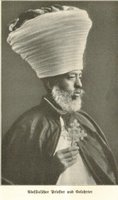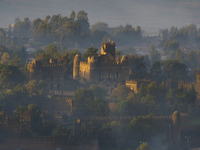Do you want to read Ethiopian alphabet or want to write your name in Geez Fidel. The first important step to is being familiar with the Ethiopian alphabet. The Ethiopian alphabets are properly termed as Geez Fidel and consist of about 28-30 alphabets. The first alphabet or Fidel is H and its name is HOY. Each alphabet in fact has its own name and was so named from the shape of the alphabet and figure it represents. For example the letter M means water and shape is like the ancient Egyptian water ripple. In fact the latin M is derived from it. Without no doudt Ethiopians exported the letter or alphabets a long time ago into Arabia, Egypt and Europe (for more imformation on this please refer to Ayele Bikeri's Ethiopic An African Writing System). The first Fidel is H and the seven different forms are Ha Hu Hi Ha Hay He and Ho. Rare forms of some alphabets have been excluded for simplicity. There is no need to spell words because the vowels are incorporated within the consonant by giving the alphabet ሀ (H) a leg, a ring, ring and leg, a broken side or a side mark. The vowel order does not change: ሀ(Ha) ሁ(Hu) ሂ(Hi) ሃ(Ha) ሄ(Hay) ህ(He) ሆ(Ho) Now how do you write Hahahahaha? ሀሀሀሀሀ Very easy!!! When Santa says HoHoHo how do you write it in Ethiopian? Its ሆሆሆ very easy!!! The donkey brays HeHoHeHoHeHo so how do you write it in Ethiopic or Ethiopian alphabet? very easy its ህሆህሆህሆ Try the following very easy test. If you pass it you can now read Ethiopic Geez Fidel alphabets and words!!! Now write in Ethiopic: He who? Hohoho hay Answer:ሂ ሁ? ሆሆሆ ሄ The same system applies to the rest of the alphabets called Fidel in Ethiopian. Try the second letter L called Lawe in Ethiopic!
Hoy h ሀ ሁ ሂ ሃ ሄ ህ ሆ Läwe l ለ ሉ ሊ ላ ሌ ል ሎ Ḥäwt ḥ ሐ ሑ ሒ ሓ ሔ ሕ ሖ May m መ ሙ ሚ ማ ሜ ም ሞ Śäwt ś ሠ ሡ ሢ ሣ ሤ ሥ ሦ Rəʾs r ረ ሩ ሪ ራ ሬ ር ሮ Sat s ሰ ሱ ሲ ሳ ሴ ስ ሶ Ḳaf ḳ ቀ ቁ ቂ ቃ ቄ ቅ ቆ Bet b በ ቡ ቢ ባ ቤ ብ ቦ Täwe t ተ ቱ ቲ ታ ቴ ት ቶ Ḫarm ḫ ኀ ኁ ኂ ኃ ኄ ኅ ኆ Nähas n ነ ኑ ኒ ና ኔ ን ኖ ʾÄlf ʾ አ ኡ ኢ ኣ ኤ እ ኦ Kaf k ከ ኩ ኪ ካ ኬ ክ ኮ Wäwe w ወ ዉ ዊ ዋ ዌ ው ዎ ʿÄyn ʿ ዐ ዑ ዒ ዓ ዔ ዕ ዖ Zäy z ዘ ዙ ዚ ዛ ዜ ዝ ዞ Yämän y የ ዩ ዪ ያ ዬ ይ ዮ Dänt d ደ ዱ ዲ ዳ ዴ ድ ዶ Gäml g ገ ጉ ጊ ጋ ጌ ግ ጎ Ṭäyt ṭ ጠ ጡ ጢ ጣ ጤ ጥ ጦ P̣äyt p̣ ጰ ጱ ጲ ጳ ጴ ጵ ጶ Ṣädäy ṣ ጸ ጹ ጺ ጻ ጼ ጽ ጾ Ṣ́äppä ṣ́ ፀ ፁ ፂ ፃ ፄ ፅ ፆ Äf f ፈ ፉ ፊ ፋ ፌ ፍ ፎ Psa p ፐ ፑ ፒ ፓ ፔ ፕ ፖ
April 16, 2011
1967 Graduates of St. Joseph High School Ethiopia

In the year 1967 Anno Domini, St. Joseph High School graduated the above students. These students have dispersed across the globe and made the world a more peaceful world to live in. Among them are their mentors (left to right) Brother Alfred, Brother Francis and Brother Eugene (?). All continued to higher learning in Engineering, Science, Law, Medicine and Business. The site of the above picture was at the Addis Ababa, Ethiopia Grand Palace (Menelik Adarash Bete Mengest) after the Diploma and Award ceremony by Emperor Haile Selassie I. One of the above students on the left is the author of the Blog Ethiopedia.blogspot.com
The 12th Grade Graduate Students are:
Basliel Wolde Gabriel; Artist for Josephite paper. Began Science Club
Buzuayehu Tedla
Marcello Capogrosso
Emanuel Cohen; He was dropped off at school in different cars
Faisal Shash
Farshad Farhoumand; His father gave the Emperor good teeth
Fikre Menbere; The Philosopher
Mebrahtu Kidane Mariam
Mulugeta Kebede
Nicholas Pangalos; The second strongest
Peter Sabadka; The strongest (not in photo)
Samuel Aberra; The Bodybuilder. Ate raw eggs for lunch
Zoran Susteric; The smartest guy from Yugoslavia (not in Photo)
Tamrat Beyene
Tesfu Haile Yesus
Tewolde Mekonnen
Branislav Vukadinovic
Yosef Yacob
Zaiyesus Abraham; nickname was "Shakespeare"
Negussu Tamrat* American Field Service Scholar
Berhane Gila* American Field Service Scholar
Girma Wolde Mariam* American Field Service Scholar
Mekonnen Assefa* American Field Service Scholar
Buzuayehu Tedla
Marcello Capogrosso
Emanuel Cohen; He was dropped off at school in different cars
Faisal Shash
Farshad Farhoumand; His father gave the Emperor good teeth
Fikre Menbere; The Philosopher
Mebrahtu Kidane Mariam
Mulugeta Kebede
Nicholas Pangalos; The second strongest
Peter Sabadka; The strongest (not in photo)
Samuel Aberra; The Bodybuilder. Ate raw eggs for lunch
Zoran Susteric; The smartest guy from Yugoslavia (not in Photo)
Tamrat Beyene
Tesfu Haile Yesus
Tewolde Mekonnen
Branislav Vukadinovic
Yosef Yacob
Zaiyesus Abraham; nickname was "Shakespeare"
Negussu Tamrat* American Field Service Scholar
Berhane Gila* American Field Service Scholar
Girma Wolde Mariam* American Field Service Scholar
Mekonnen Assefa* American Field Service Scholar
March 26, 2011
Stamps of Ethiopia Volume 3
The top stamps were issued at the Golden Jubilee or the 50th Anniversary of the marriage of Emperor Haile Selassie and Empress Itegue Menen (1911-1961). The second row of stamps were issued in August 1929 and depicts the plane called Nessre Tafari meaning the Teferi Eagle. Eritrea at this time is not part of Ethiopia and the monetary value is the Guerche (derived from the Arabic Gerch). The stamps (last rows) were issued in 1928 during the reign of Empress Zewditu and Ras Teferi and demonstrates the wildlife of the country and notable Ethiopians, including Zewditu and Teferi (Tafari). Click on the image for enhanced and enlarged view of these stamps. 

March 24, 2011
Stamps of "Ethiopia" Volume 2
These series is really the most ridiculous stamps bearing the name of the Holy Land of Ethiopia. The Italian Fascists were in Ethiopia fighting for survival for 5 years but they still managed to produce these stamps before they melted away back to Italia Irredenta where they came from!The Arabic script reads "Al Balad El Habasha" which means Country of the Habash or Abyssinian while the year reads May 9 1936, the date the Italians declared Ethiopia as a colony. They entered Addis Ababa on May 5 1936 and declared the next day May 6 as Occupation of Ethiopia. Mussolini declared Ethiopia an Italian province. Victor Emanuel III, shown below, was proclaimed as the new Emperor of Ethiopia. This is quite an accomplishment even though the Italian Fascists never colonized the country except for the complicated case of Eritrea (also known as Baher Midri, Baher Meder, Mereb Melash, Ertra).
March 23, 2011
Life: Do Not Worry Cheer Up and Be Happy!!!!
As the human population of the earth increases uncontrollably, so does all the old problems and new emerging problems that have to be dealt with. Sometimes however, one is cornered and has no weapons left to fight the encroaching phenomenon. Some take the easy way out by jumping from the highest buildings or the deepest sea. Others use myriads of ways or a thousand ways to die and leave the earth for another wonderful far-away planet that had been etched in their imaginations. But the tough human spirit is to adapt and not to perish. Ethiopedia has therefore posted this copyrighted poem or fighter's chants to conquer the evil Great Ones that may come in your path as you journey through life. It may be earthquakes, Tsunami, Joblessness, Anger, Prejudice, Hatered etc. Please read it and dance your way until victory!
 Copyrighted 1988 Basliel Wolde Gabriel
Copyrighted 1988 Basliel Wolde GabrielStamps of Ethiopia Volume 1
November 26, 2010
Ethiopian Beauty Pageant Some History Some Problems
A group of Ethiopians under the name of Ethio American Entertainment Inc. organized in 1988 the first Ethiopian Beauty Pageant in Washington DC. Herein is the events that took place in that year. A summary of the booklet distributed at the pageant identifies all the participants, the early history of pageants in the world and the Miss Addis Ababa Beauty Contest ( Amharic ; Kungena Wededer)of 1964 and 1968.
This Site is being Constantly Upgraded with New Information !!!!!!!!!!!!!!!!
The cover photograph of the Miss Ethiopia Pageant booklet shows Wossene Hailu being crowned in 1968 as Miss Addis Ababa by Vice President Hubert Humphrey.

Emperor Haile Selassie Receiving Wossene Hailu the Miss Addis Ababa of 1968 at the palace. The Haile Selassie University students at this time refered to the vice president as Kubet Humphrey. Kubet in Amharic means dried cow dung. Most of the students were radicalized Marxist oriented protesters against the feudal government.

Congratulatory Letter from Vice President Hubert Humphrey to Wossene Hailu, the 1968 Miss Addis Ababa.






The Ethiopian Beauty Pageant contestants were listed in the booklet with their names, date of birth, education and interests. A brief account of their backgrounds was also listed. There was no uniform pattern in the photographs and it seems that either they provided whatever photos they could get hold of from the contestants or there was a photo shot taken by the organizers. Thus there seems to be two or three classes of appearances, the Western look, the traditional look and the business-like look. One contestant even appears in blue jeans. Regardless, the photos in the booklet was for information only but it could have been an influence in the selection for the winner of Miss Ethiopia by the judges.







Etenesh Wondemu (above) won the Miss Achievement catagory in the 1988 Miss Ethiopia Pageant. Her charisma, energy, confidence and looks certainly paid off!!
 Sehin Belew the New Miss Ethiopia 1988 of the Washington DC Pageant at Hilton Hotel
Sehin Belew the New Miss Ethiopia 1988 of the Washington DC Pageant at Hilton Hotel
This Site is being Constantly Upgraded with New Information !!!!!!!!!!!!!!!!
The cover photograph of the Miss Ethiopia Pageant booklet shows Wossene Hailu being crowned in 1968 as Miss Addis Ababa by Vice President Hubert Humphrey.

Emperor Haile Selassie Receiving Wossene Hailu the Miss Addis Ababa of 1968 at the palace. The Haile Selassie University students at this time refered to the vice president as Kubet Humphrey. Kubet in Amharic means dried cow dung. Most of the students were radicalized Marxist oriented protesters against the feudal government.

Congratulatory Letter from Vice President Hubert Humphrey to Wossene Hailu, the 1968 Miss Addis Ababa.






The Ethiopian Beauty Pageant contestants were listed in the booklet with their names, date of birth, education and interests. A brief account of their backgrounds was also listed. There was no uniform pattern in the photographs and it seems that either they provided whatever photos they could get hold of from the contestants or there was a photo shot taken by the organizers. Thus there seems to be two or three classes of appearances, the Western look, the traditional look and the business-like look. One contestant even appears in blue jeans. Regardless, the photos in the booklet was for information only but it could have been an influence in the selection for the winner of Miss Ethiopia by the judges.







Etenesh Wondemu (above) won the Miss Achievement catagory in the 1988 Miss Ethiopia Pageant. Her charisma, energy, confidence and looks certainly paid off!!
 Sehin Belew the New Miss Ethiopia 1988 of the Washington DC Pageant at Hilton Hotel
Sehin Belew the New Miss Ethiopia 1988 of the Washington DC Pageant at Hilton Hotel Update Information; http://www.sehinbelew.com/
http://sehinbelew.authorweblog.com/
Sehin Belew in 2010, more than 20 years later and still looking good! Her secret for being fabulous every day is revealed in her recent book titled Fabulous for Less!






http://sehinbelew.authorweblog.com/
Sehin Belew in 2010, more than 20 years later and still looking good! Her secret for being fabulous every day is revealed in her recent book titled Fabulous for Less!






November 17, 2010
History of Medicine in Ethiopia
CIBA SYMPOSIA describes the medical situation of Ethiopia in 1944 after the end of the Italo-Ethiopian war. It also describes the establishment of the various hospitals and clinics in Addis Ababa and Ethiopia. Click on the images for better viewing. The report continues with descriptions of the diseases commonly found in Ethiopia such as malaria, venereal diseases, tuberculosis, leprosy, typhus diseases, relapsing fever, cholera, yellow fever, smallpox, helminthic diseases, diseases of the the skin, gastrointestinal disturbances, eye diseases, framboesia and some disease terms in Amharic. These diseases are generally catagorized under Tropical Diseases as contrasted with diseases in the United States and most developed countries wherein the diseases are described as sort of Metabolic, Carcinogenic and Modern society sedentary diseases.










November 12, 2010
Native Medicine in Ethiopia 1944
Native medicine in Ethiopia is described by U.S. Technical Project in CIBA Symposia after the Italo-Ethiopian War. The findings, which is incomplete and partial, has pitfalls since many traditional herbal medicines is not described. It is interesting that Kosso is mentioned and today European companies have identified one of the active ingredients of Kosso in the lab. Sadly, they have peddled the "Kossin chemical" as their own to the Ethiopians with tragic consequences to some patients. Ethiopians, however, are able to better describe their traditional or folk medicine (a better terminology) as in this article of another expectorant by Amare Getahun.
"Some Common Medicinal And Poisonous Plants Used In Ethiopian Folk Medicine" :
Rosaceae
Rosa abyssinica R.Br.
keqa (A)
wild Ethiopian Rose (English)
The edible fruits are good tapeworm and round worm expectorants
Rosa abyssinica R.Br.
keqa (A)
wild Ethiopian Rose (English)
The edible fruits are good tapeworm and round worm expectorants
CIBA Pharmaceutical Report on Native Medicine in Ethiopia







November 02, 2010
Artistic Works of Adis Gebru of Ethiopia
Ethiopia has produced many artists throughout the long history of the country. The illuminated manuscripts, as an example, are some of the longest surviving works produced by selfless and patient artists in the early history of Ethiopia. Certain books in the West have shamelessly described the arts of Ethiopia as cartoon-like and childish in appearance. This is far from the truth! Shown below are the works of the artist Adis Gebru dated 2008 of traditional Ethiopians as they are without the flair of Westernizations. Their Ethiopic looks are now well known through the world and this characteristics has been carried unchanged through 4000 years of their history and independence. This is just one example of many talented Ethiopian artists.
The titles of the painting (bold) and comments by Ethiopedia
1. Long Trip. Man and child. Men nurture kids and traditionally are referred to as having given birth to a child like a women
The titles of the painting (bold) and comments by Ethiopedia
1. Long Trip. Man and child. Men nurture kids and traditionally are referred to as having given birth to a child like a women

2. Netella Wear. This is the traditional wear of the Highlander Ethiopians

3. My Coffee Maker. Coffee from Kaffa Ethiopia still grows wild in the shadows of the forests and the coffee ceremony is a favorite of many Ethiopian restaurants and homes

4. Impressionable Age. Children are very much loved and protected in Ethiopia

5. Spinning. This cotton spin tradition has not changed since the times of the Pharoahs as seen in the Persian relief below


6. Interesting Style. Ethiopian women like to adorn themselves just like their black kins in Egypt including the same cotton dress with same design


7. Reminescence. The older you are the wiser, so the Shimageles (Elders) are sought for wise advices

8. Stylish. An Oromo lady proudly posing her good looks

9. Adorned. Ethiopian women are much sought after but are good fighters too if disrespected.

Subscribe to:
Comments (Atom)









